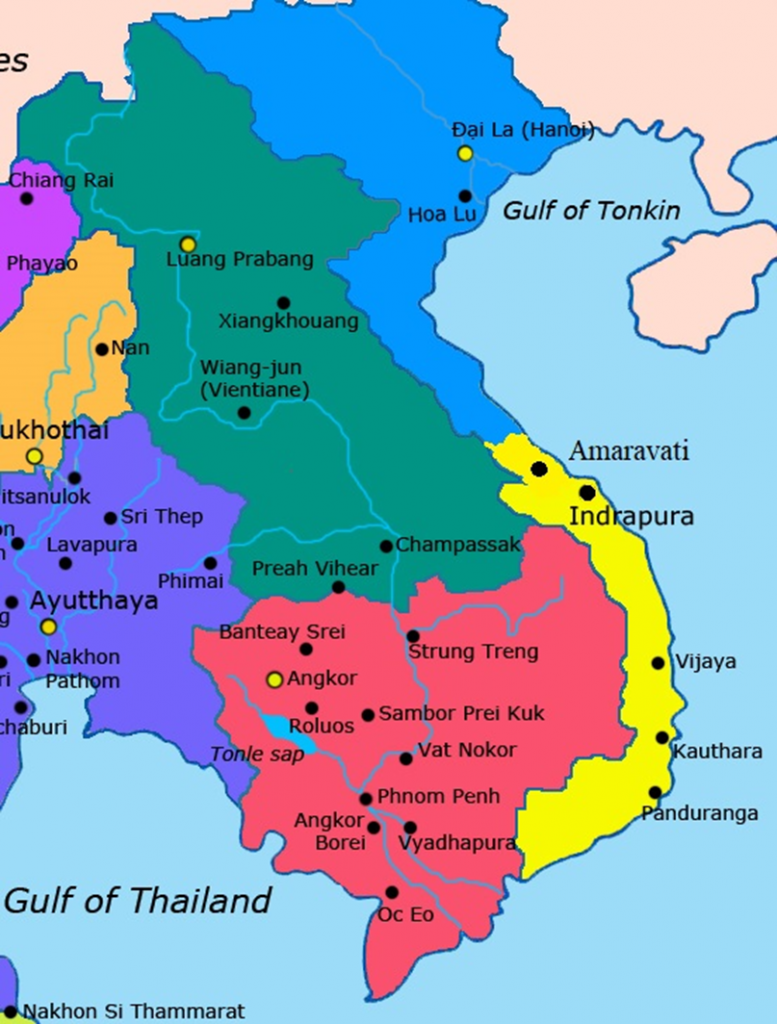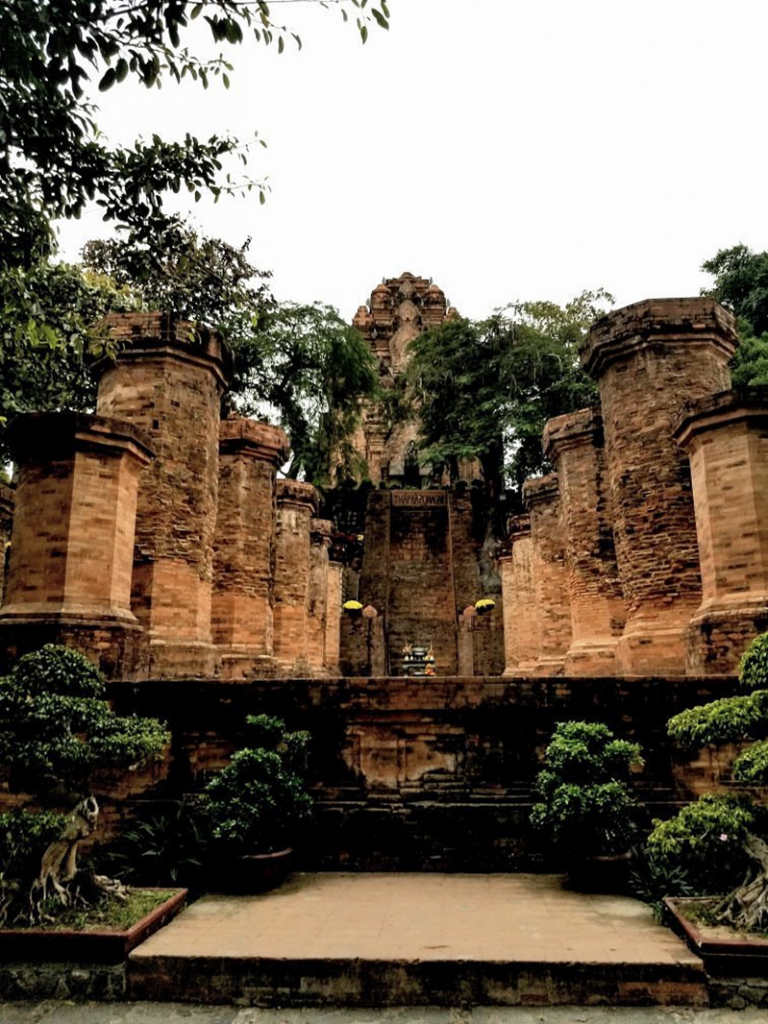by Andy Khong
The Champa Empire appeared out of nowhere and vanished as if it never existed. It left behind a rich cultural legacy in Vietnam and Cambodia that included thousands of relics, temples, and monuments. Today many people are unaware that Champa Empire existed at all.
Champa Empire was a historical Indianized kingdom that existed from around the 2nd century CE to the 19th century CE in what is now modern-day central and southern Vietnam, and part of Cambodia. Influenced by Indian culture, the empire thrived as a maritime power, engaging in extensive trade and participating in regional politics.
The Champa Empire had various capitals throughout its existence, including Indrapura, Simhapura, Vijaya, and Panduranga. Organized into mandalas ruled by local leaders called Rajadhirajas, the empire reached its pinnacle during the 8th and 9th centuries under the Sailendra dynasty. It boasted prosperous agriculture, thriving trade networks, and remarkable achievements in art, architecture, and religion. Hinduism was the primary religion, but Buddhism also held influence.

Map of Champa Empire.
In the 8th century, Indian merchants introduced Islam to the Cham people and when some royal family members converted to the faith in the 11th century, it became the state religion. Hence the majority of Cham people in Vietnam and Cambodia are Muslims today.
However, conflicts with neighbouring powers, such as the Khmer Empire and Dai Viet (Vietnam), as well as European colonialism’s rise, led to the empire’s gradual decline. It eventually succumbed to Vietnamese forces in the 15th century, finally assimilating into the Vietnamese state in 1832.
Admiral Cheng Ho~ (spelled Zheng He in Pinyin Mandarin), was a renowned Chinese explorer and diplomat who undertook seven major expeditions during the early 15th century. One of his notable voyages was to the Champa Empire. Cheng Ho’s exploration of the Champa Empire took place between 1405 and 1407. The purpose of this expedition was to establish diplomatic ties, enhance trade relations, and assert China’s influence in the region. The Champa Empire was an important trading partner for China, and Cheng Ho sought to strengthen these economic connections. With his massive fleet of ships, including the famous treasure ships, Cheng Ho sailed from China to Champa, docking at key port cities such as Hội An^. The Champa rulers received him and his entourage with great respect, recognizing the power and prestige of the Ming Dynasty that Cheng Ho represented. During his time in Champa, Cheng Ho engaged in diplomatic negotiations, exchanged gifts, and forged alliances with local Champa leaders.
Not many people are aware that on his fourth and final voyage, Christopher Columbus, tried to reach the Champa Empire and thought he was in Vietnam. By the 1400ies, political instability had upset trade exchange between India and the West. At that time, the majority of Europeans held the belief that the Earth was flat, but Columbus was convinced that he could circumnavigate the globe by sailing west from Spain. By doing so, Columbus felt that he could find a new trade route and re-establish the long-lost connection to the wealth of the East. He intended to travel south along the coast of Vietnam, past the Cape of Cattigara, and on to Malacca* (Melaka); a route Columbus believed that Marco Polo had travelled from China to India in 1292. He thought he had found Vietnam when he got to Cariay, on the Costa Rican coast in 1502; which he thought was the famous gold mines of ‘Ciamba’ (Champa) Empire.
While the Champa Empire no longer exists as an independent entity, remnants of its rich history can be found in the form of archaeological sites scattered throughout central and southern Vietnam. These sites offer glimpses into the civilization’s past glory, architecture, and religious practices. Some notable Champa ruins include:
- Mỹ Sơn: Situated in the Quảng Nam Province, Mỹ Sơn is a significant Champa archaeological site and former religious and political capital. It features a complex of Hindu temples and towers, many dating back to the 4th to 14th centuries. Mỹ Sơn is recognized as a UNESCO World Heritage Site.
- Po Nagar: Located near Nha Trang in Khánh HòaProvince, Po Nagar is a temple complex dedicated to the Hindu goddess Yan Po Nagar. The site comprises several structures, with the main tower dating from the 8th century. It remains an active place of worship for the Cham people.
- Đơn Dương: Found in the Quảng Nam Province, Đơn Dương served as a significant religious and cultural centre of the Champa Empire. The site contains ruins of a large temple complex, including a central tower and surrounding structures.
- Trà Kiệu: Also known as Simhapura, Trà Kiệu was an ancient capital of the Champa Empire. It played a vital role politically and economically and now houses ruins of temples, tombs, and other structures.
- Po Klong Garai: Situated near Phan Rang in Ninh Thuận Province, Po Klong Garai is a Champa temple complex dedicated to the deity Shiva. Its prominent features include a tall tower and several smaller shrines.

Mỹ Sơn.

Po Nagar.

Đơn Dương.

Trà Kiệu.

Po Klong Garai.
These Champa ruins provide valuable insights into the empire’s architectural style, religious beliefs, and cultural heritage. They attract visitors from all over the world, allowing them to explore Vietnam’s fascinating historical past and appreciate the legacy of the Champa civilization.
Come to visit Champa’s haunting ruins and walk in the footsteps of a lost empire!
* Malacca (Melaka) today: https://www.youngpioneertours.com/malacca-city-steeped-in-history/
~ Admiral Cheng Ho: https://www.youngpioneertours.com/admiral-cheng-ho-astonishing-explorer-sinbad/
Other places of interest in Vietnam –
^ Hội An: https://www.youngpioneertours.com/hoi-an/
Huế: https://www.youngpioneertours.com/hue-imperial-city-of-vietnam/
Cao Đài religion: https://www.youngpioneertours.com/cao-dai/
Go to Po Nagar Temple Complex with YPT’s Ultimate South East Asia Adventure: https://www.youngpioneertours.com/tour/ultimate-south-east-asia-adventure/





